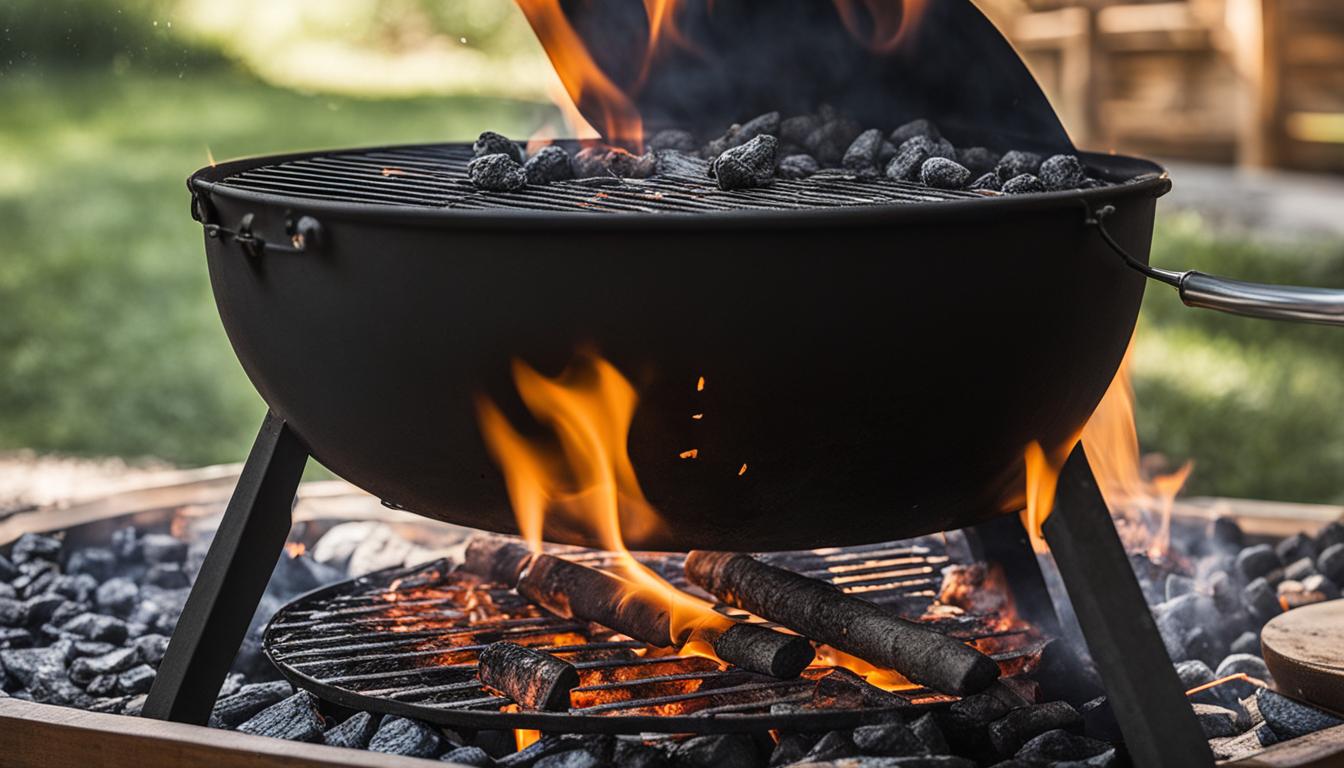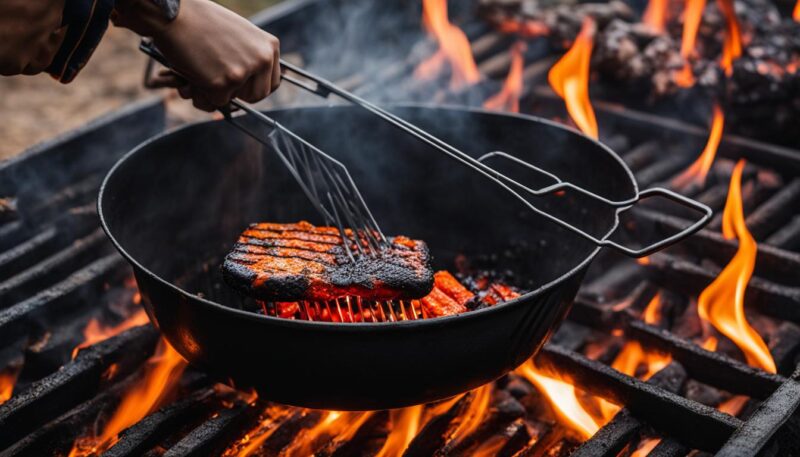When it comes to outdoor cooking, mastering the technique of how to put out a charcoal grill is as essential as the culinary skills you use to create those sizzling steaks and veggie skewers.
Whether you’re unwinding at home or enjoying the wilderness on a camping trip, knowing the appropriate charcoal grill extinguish methods can save you time, charcoal, and ensure your safety.
I’ve learned that flexibility is crucial; sometimes you have the leisure of using the long method for putting out a charcoal grill, while at other times, the quick method for putting out your charcoal grill becomes necessary. Both approaches are foolproof when followed correctly, and I’m here to guide you through each one.
The heart of extinguishing a charcoal grill lies in controlling its oxygen supply. A grill like the Weber Kettle is equipped with adjustable intake and exhaust vents that make the process straightforward when you know what you’re doing.
The key is to clamp these vents shut, effectively choking out the fire, and allowing the coals to cool down gently. This not only stops combustion but can also enable you to reuse your coals—making it a win-win situation.
But what do you do if time is not on your side? With protective gear and the right tools, the hot coals can be swiftly dealt with, dousing them decisively and swiftly transitioning from grilling maestro to safety expert. I’ve delved into both methods in a way that ensures you won’t end up with singed eyebrows or a smoldering backyard.
Understanding the Importance of Grill Fire Safety
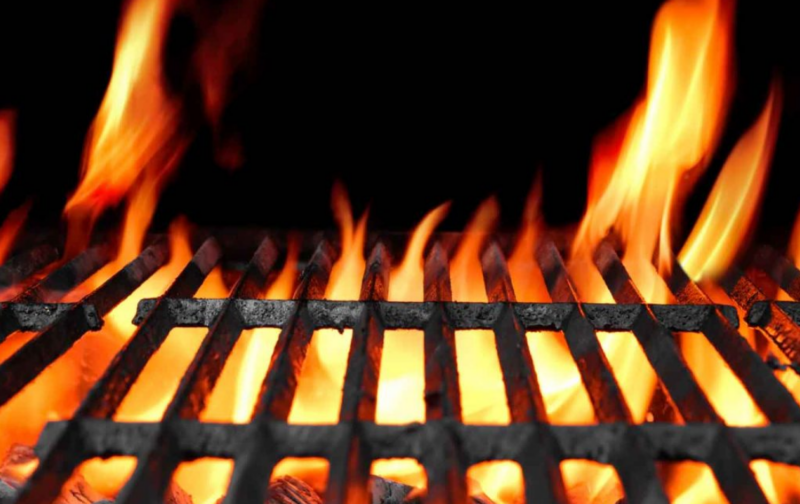
Grill fire safety is an aspect of outdoor cooking that cannot be overstated. Not only is it a cornerstone of responsible grilling, but it also guards against potential disaster. The importance of thoroughly extinguishing charcoal grills is paramount to prevent accidental fires – a smoldering grill can endanger families, pets, and property alike.
I’ve gathered some essential fire safety tips for charcoal grills that are both simple to follow and effective in ensuring a safe grilling environment.
My approach to grill fire safety encompasses several precautions. First, it involves making sure that all coals are completely extinguished, which reduces the risk of falling prey to a common misconception that coals die out soon after cooking.
This bears repeating: a neglected grill poses significant risks of reignition and fire spread – a cautionary tale I’ve seen lamented in many outdoor grilling circles.
- Always use noncombustible bins for coal and ash disposal.
- Keep a close eye on the grill until it has fully cooled and is safe to leave unattended.
- Equip yourself with tools and techniques for effective extinguishing charcoal grills, such as closing off oxygen supply and using appropriate extinguishing agents.
In my experience, even professionals can benefit from routinely revisiting the basics of grill fire safety. For those new to the grill, it can be crucial in laying a foundation of conscious, safety-first grilling habits that will last a lifetime.
A personal anecdote further underscores this point. On one occasion, after a neighborhood barbecue, an unattended grill led to a nighttime fire scare that rallied the community.
Thankfully, no harm was done, but the incident hammered home the importance of vigilance and adherence to established safety practices.
Knowing how to safely and effectively handle charcoal post-cooking, particularly in the presence of residual heat, is a keystone skill for any grilling enthusiast. In fact, it can make all the difference between a successful barbecue and unsolicited drama.
The negligence of proper grill extinguishment is a silent saboteur of safety. Vigilance is not just recommended but required.
The goal of this section is not to alarm but to empower. The fire safety tips for charcoal grills presented here are gleaned from reputable sources and personal practice. As with any pursuit, knowledge paves the way for proficiency, and with grill fire safety, an ounce of prevention is indeed worth a pound of cure.
The Basics of Charcoal Grill Extinguishing
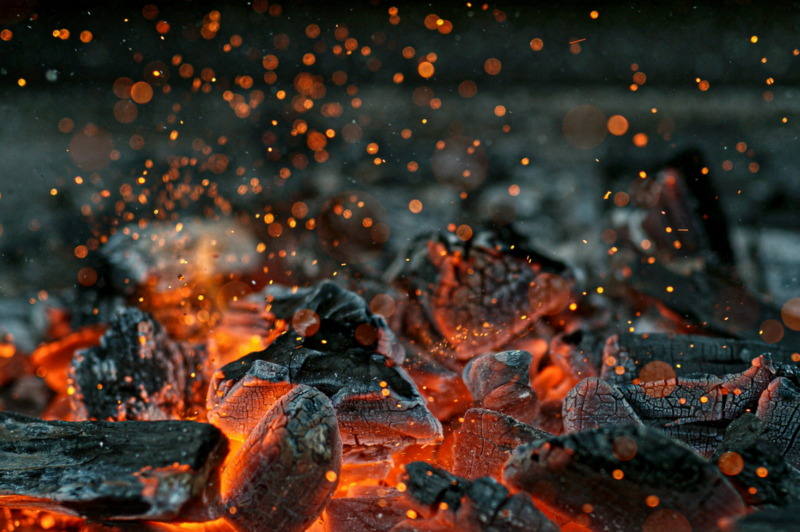
As an avid griller, I’m all too familiar with the importance of properly extinguishing charcoal grills. Overlooking this critical step can lead to wasted resources and, more importantly, pose serious safety risks.
Let us share with you why oxygen control is at the heart of safely putting out a grill fire, how to recognize when it’s time to start extinguishing, and what tools you’ll need for effective and secure charcoal disposal.
Why Oxygen Control is Crucial
Oxygen is the lifeblood of fire; without it, a fire cannot sustain itself. That is why putting out grill fires fundamentally means eliminating the grill’s oxygen supply. This is effectively done by closing both the air vents and the grill lid.
A charcoal grill like the Weber Kettle, which comes with adjustable vents, allows for precision in managing airflow to the coals, ensuring that the fire extinguishes slowly and safely to prevent any potential fire hazards or reignition.
Grill safety and responsible grilling practices dictate this method as the most important step in charcoal grill maintenance post-cooking. It’s an approach that not only minimizes risk but also conserves charcoal for future use.
Recognizing the Right Time to Start Extinguishing
The adage ‘timing is everything’ rings true when it’s time to extinguish your charcoal grill. The right time is after your grilling duties are done, and the coals are no longer needed.
By waiting just long enough for the coals to exhaust most of their energy but before they’ve entirely died out, you can ensure efficient and orderly shutdown practices without wasting useful charcoal or leaving behind a potential fire hazard.
A proper understanding of charcoal grill safety principles is indispensable when learning to spot the precise moment to commence the extinguishing operation. My rule of thumb has always been to start the process once grilling is finished, and the coals have burned down to a consistent glow.
Selecting the Right Tools for Charcoal Extinguishment
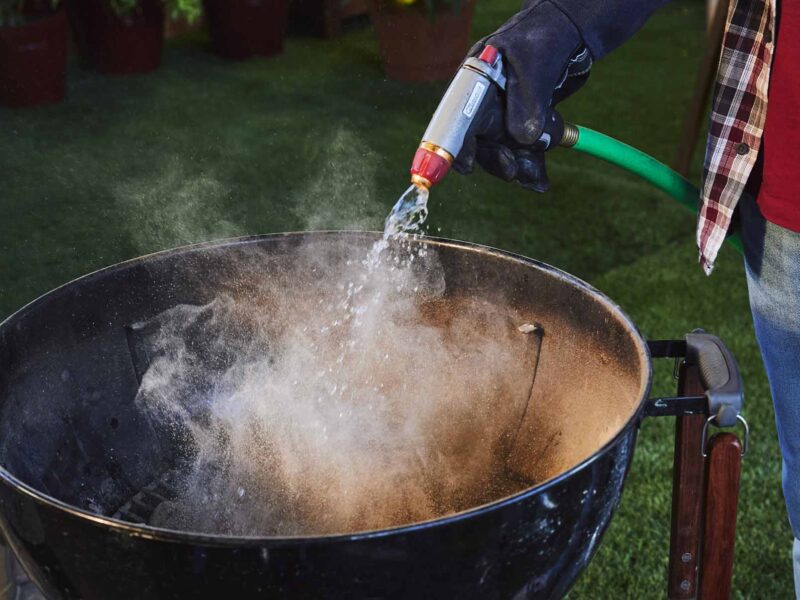
In my toolkit for extinguishing charcoal grills, a few essential items make the job safer and cleaner. Here’s a rundown:
- A wire grill brush for sweeping out cooled ash and residue
- Grill tongs, a necessity for handling hot coals
- Heatproof gloves to protect your hands during the process
- A bucket of water—preferably with baking soda to quench remaining heat
These instruments are vital for properly putting out grill fires without exposing oneself to burns or exacerbating a modest fire hazard into a full-fledged incident.
Furthermore, disposing of the residual charcoal and ash securely is pivotal to complete the extinguishing process. The below table provides a clear guideline on how to handle remnants responsibly:
| Material | Tool/Method | Use |
|---|---|---|
| Hot Coals | Grill Tongs and Heatproof Gloves | Safe Transfer to a Metal Bucket |
| Ash | Wire Grill Brush and Baking Soda | Cleaning Grill Base and Absorbing Heat |
| Partially Spent Coals | Aluminum Foil | Wrapping and Disposal |
Remember, the goal is not to tackle the fire with aggressive or rushed tactics, but rather to methodically and safely bring the temperature down and ensure that all embers are extinguished — a vital part of charcoal grill maintenance and safety.
Essential thought for grill enthusiasts: Taking the time to extinguish your grill properly is not just conscientious; it’s the mark of a true grilling master.
Long Method for Putting Out Charcoal Grill: Oxygen Deprivation
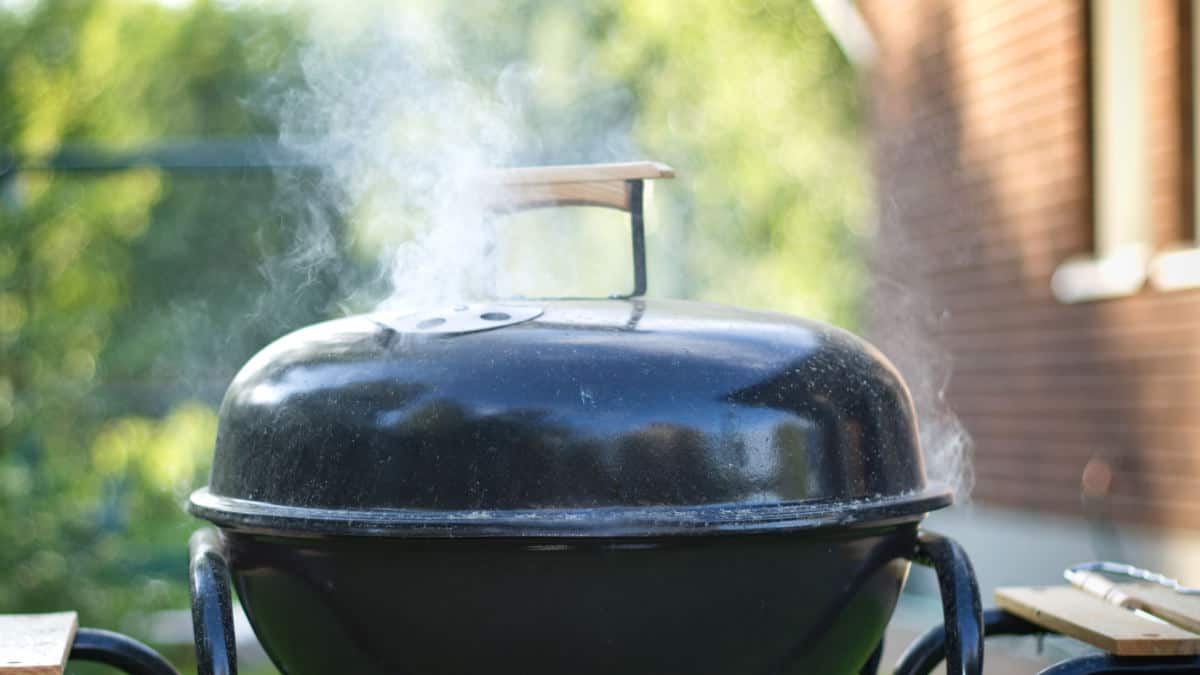
As someone who takes pride in the art of grilling, I’ve always upheld the long method for putting out a charcoal grill as a foundation of comprehensive grilling practices. The principle behind this approach is straightforward – oxygen deprivation.
When I’m finished savoring the flavors of my backyard barbecue, I make it a habit to close off the oxygen supply to the charcoal, the very element that fires up the grill. The meticulousness of this method lies in its ability to ensure a safe and efficient cool-down period.
The process involves meticulously shutting down the grill, thereby cutting off the oxygen by sealing the lid and vents. This method ensures that the charcoal is not hastily discarded but allowed to extinguish slowly and naturally.
Much like enjoying a fine wine after a meal, this process is not to be rushed; it is ideal for instances when you can allow the grill to cool in the background, such as after home cookouts when you’re unwinding with family and friends.
Using the long method for putting out a charcoal grill is akin to allowing a fine dish to rest – it is essential to the process and ensures optimal outcomes in safety and future grill readiness.
To provide a clearer picture, let’s delve into the steps I follow to secure the grill post-use:
- Upon completing the culinary activities, I close the grill lid tightly, ensuring no gaps are present for air to seep through.
- The next crucial step is to shut off any airflow by tightly closing the intake and exhaust vents. On my Weber Kettle, these adjustable vents allow for smooth precision, guaranteeing that I can stifle any lingering embers adequately.
- After these steps, it’s simply a waiting game. The coals will cool down eventually, the time for which can be spent reveling in the aftermath of a delightful meal.
By using the long method, I also emphasize charcoal grill extinguish methods that enable a conservation of resources. Properly extinguished coals can often be reignited for the next grilling session, thus preventing unnecessary waste and prolonging the life of my charcoal supply.
Responsibility toward one’s surroundings should never be underestimated, and this process epitomizes that responsibility. It’s a ritual that lets me wind down with the same ease as the dying coals, guaranteeing that the only things awakening are the memories of the day’s feasting.
Moreover, I always ensure I’m equipped with the following tools to employ the long method effectively:
- Heatproof gloves, for any inadvertent handling of warm components.
- A sturdy set of grill tongs, should there be any need to arrange leftover coals for next time.
- A metal container for ash collection, following complete extinguishment and cooling.
By adhering to these established and efficient charcoal grill extinguish methods, I confidently close out each grilling endeavour safely and satisfactorily, knowing I’ve paid due diligence to every aspect of the process.
Quick Method for Putting Out Charcoal Grill: Rapid Cool Down
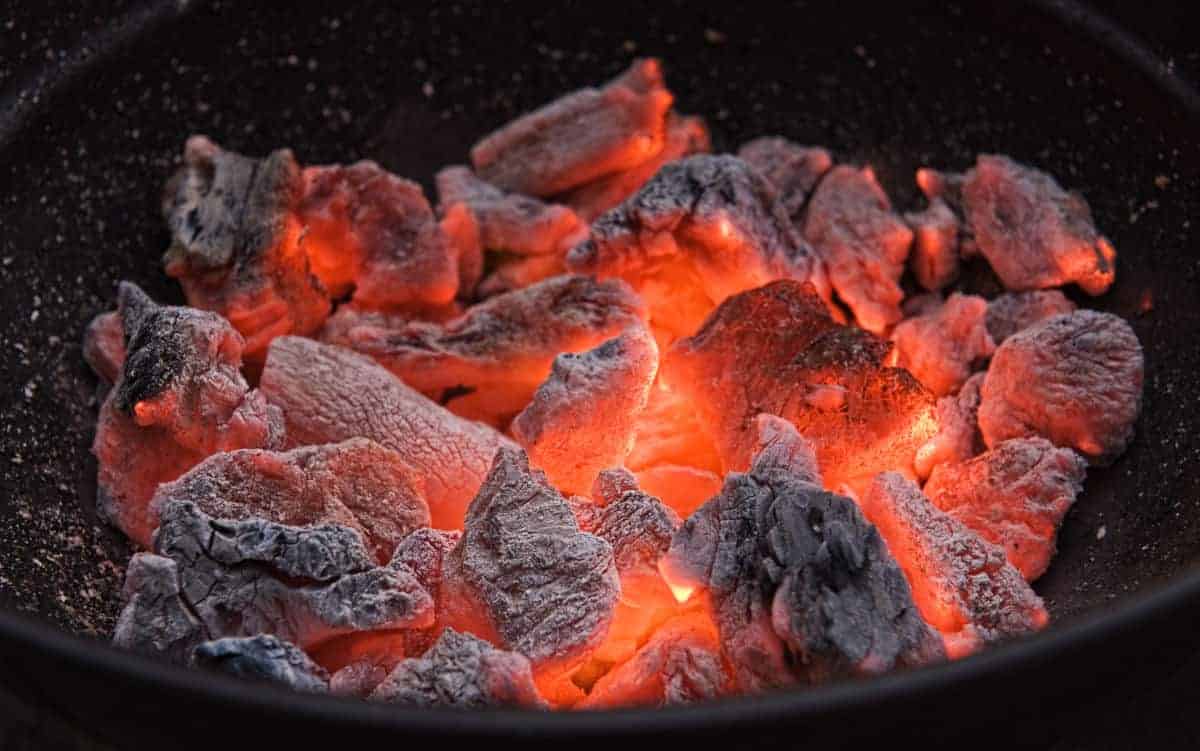
When time is of the essence, and I need to expeditiously cool down my charcoal grill, I opt for the quick method for putting out charcoal grill. This method is catered towards those moments when I can’t afford the luxury of a slow burnout or when safety requires that the grill be extinguished with immediacy.
This section focuses on one of the most efficient charcoal grill extinguish methods available, a method that should be handled with care to ensure safety is not compromised.
Handling Hot Charcoal Briquettes Safely
Dealing with searing hot charcoal demands attention to detail and the appropriate safety measures. To initiate the rapid cool down, I begin by donning my heatproof gloves, ensuring my hands are shielded from the intense heat.
Using long tongs, I carefully remove the individual charcoal briquettes, respecting the latent energy they hold even after the flames have subsided.
Each briquette is subsequently lowered into a metal bucket filled with cold water—a receptacle that is resilient to the briquettes’ high temperatures. This action quenches the lingering heat swiftly and effectively. However, it’s important to maneuver this stage cautiously to avoid splashing or the release of steam, which can pose its own risks.
- Don heatproof gloves
- Use long tongs to remove briquettes
- Submerge briquettes in water-filled metal bucket
Once the immediate threat of the hot coals is addressed, the next step in the rapid cool down is to remove any residual ash. It’s here that I utilize a metal scoop, gently transferring the ash into a separate metal container.
The ash container should be free from flammable materials, ensuring a secure storage solution until the ash fully cools.
And it’s not only about the coals and ash—my tools also require mindful handling. Post-cooling, I make certain that my hot tongs are placed on a non-flammable surface, preventing any inadvertent heat damage to my surroundings or tools.
The table below summarizes the key actions and the corresponding safety equipment essential to the quick method for putting out charcoal grill:
| Action | Safety Tool | Purpose |
|---|---|---|
| Removal of Hot Briquettes | Heatproof Gloves and Long Tongs | To protect hands and safely handle hot coals |
| Quenching Coals | Metal Bucket with Cold Water | To rapidly cool down hot charcoal |
| Ash Removal | Metal Scoop and Container | To safely dispose of residual ash |
| Tool Storage | Non-flammable Surface | To place hot tools without risk |
It’s imperative to underscore that while the quick method for putting out charcoal grill leads to a rapid cool down, it should never be rushed or done without proper protective gear and adherence to safety protocols.
Every time I embark on these charcoal grill extinguish methods, my priority remains unwavering: to complete the process effectively, but most importantly, safely.
Remember: Urgency should not come at the cost of safety. Proper protective wear and careful handling define the rapid cool down technique.
How to Deal with Remaining Ash and Charcoal
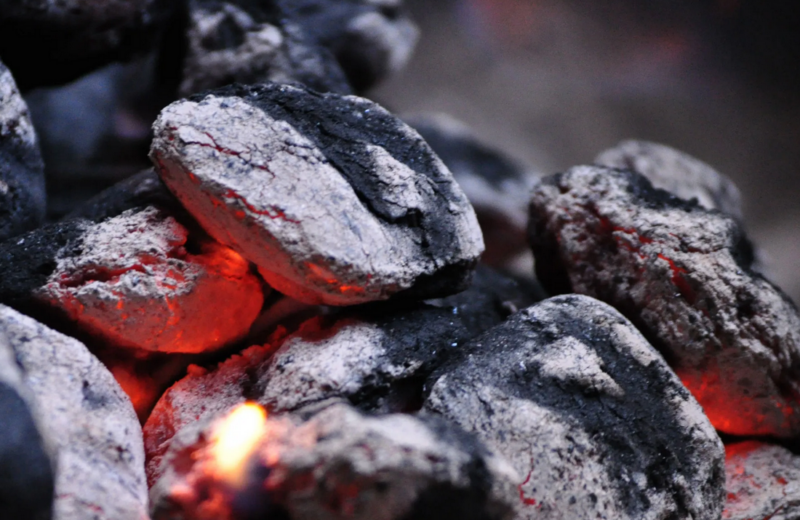
My practice of charcoal grill maintenance always includes dealing with the remaining ash and unburnt charcoal once the grill has cooled. An important step in extinguishing charcoal grills effectively is to ensure that no ash or unburnt pieces are left behind, preventing potential issues during the next use.
Here, I’ll detail the comprehensive approach that not only keeps the grill clean but also adheres to safety guidelines.
First, I don my trusty gloves to protect my hands, and gather the tools needed for a thorough cleaning. The ash and remnants from my previous grilling adventure are my primary focus at this stage. What follows is a step-by-step guide to ensure that my grill is well-maintained and prepared for future outings.
Proper disposal of ashes and unburnt charcoal is a cornerstone of responsible grill ownership, setting the stage for safe and satisfying future cookouts.
- With a wire brush, I carefully sweep the cooled ash off the bottom of the grill.
- Any large pieces of unburnt charcoal are set aside — these can be salvaged and used during my next cookout.
- The collected ash is placed in a piece of aluminum foil for convenient and safe disposal.
Cleaning the grill thoroughly is crucial too. I use a brush and a mixture of water, and when necessary, a bit of soap to ensure that any residual ash is removed. This not only maintains the integrity of my grill but also prevents any bitter flavors that may arise from charred remains during my next grilling session.
| Cleaning Step | Tool/Method | Purpose |
|---|---|---|
| Ash Removal | Wire Brush | Clear out residual ash and prevent corrosion. |
| Charcoal Salvage | Heatproof Gloves | Handling and sorting through remnants for reusable coals. |
| Washing | Brush and Water/Soap | Clean grill grates and interior to ensure a clean cooking surface. |
It’s these seemingly trivial tasks after a day of grilling that contribute immensely to the overall longevity and performance of my charcoal grill. I make it a habit to prioritize this cleanup regimen right after extinguishing charcoal grills, setting a standard for meticulous grill care that ensures my grilling experiences remain top-notch.
Proper Disposal Techniques for Charcoal Ash
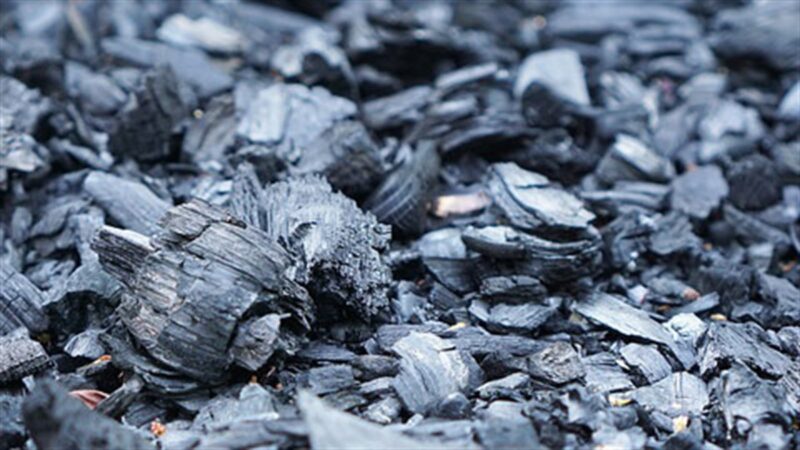
Post-grilling cleanup is as essential as the preparation of the feast itself, and understanding the proper disposal techniques for charcoal ash is vital to this process.
The residual ash and charcoal must be handled with utmost care, not only to maintain a clean grill for your next barbecue session but also to ensure environmental safety and adhere to conscientious trash disposal practices.
Let’s delve into the methods that ensure the safe disposal of charcoal ash, while also incorporating important environmental considerations.
Environmental Considerations and Trash Disposal
Environmental responsibility weighs heavily on my mind when I discard post-grill remnants. Utilizing a metal container for ash and charcoal disposal is my go-to method, ensuring that the remnants cool off efficiently while minimizing ecological impact.
These containers, preferably with perforations for airflow, not only allow for better cooling but also mitigate the risk of restricted air leading to spontaneous combustion of residual coals.
It’s imperative to consider the type of container used. Confirming that the waste receptacle is not marked “No Hot Ashes” is a crucial step in avoiding unsightly incidents like container fires or damage.
Preventative measures like wrapping the completely cooled ash in aluminum foil are not just a neat disposal trick but an essential practice for preventing the melting or ignition of plastic trash containers.
Ensuring environmental integrity and safety goes hand-in-hand with proper disposal techniques for charcoal ash. Recycling and reducing waste begin with the choices we make at the end of our grilling adventures.
To illustrate the process, I have detailed the necessary steps and considerations for responsible ash and charcoal disposal into a cohesive table:
| Disposal Step | Action | Environmental Impact |
|---|---|---|
| Cooling Period | Allow ash and charcoal to cool completely in a secure, non-combustible area. | Prevents potential fire hazards, protecting natural surroundings and property. |
| Transfer to Perforated Metal Container | Ensure container is marked for hot ash disposal to permit safe ventilation. | Provides controlled airflow reducing the risk of covert ember reignition. |
| Aluminum Foil Wrapping | Wrap completely cooled ash in aluminum foil before placing it in the trash. | Prevents the melting of plastic bins or unintended fires, preserving resources. |
| Final Disposal | Place wrapped ash in a trash receptacle designated for non-recyclable waste. | Disposal aligns with local waste management protocols, bolstering community efforts. |
In observing these steps and documenting them for others to emulate, my commitment to environmental stewardship resonates throughout my grilling practice. The table above serves not simply as a guide for myself but as an entreaty to fellow grill enthusiasts to embody responsible and environmentally considerate disposal habits.
- Always let charcoal ash cool off completely before disposal to prevent accidents.
- Invest in a metal container with perforations for ash disposal, ensuring proper extinguishment and cooling.
- Aluminum foil is a griller’s ally in clean and safe ash disposal.
- Never undermine local trash disposal regulations—exercise due diligence in waste management.
As a steward of both flame and earth, my passion for grilling is matched by my commitment to proper disposal techniques for charcoal ash. Ensuring that every step from lighting the coals to disposing of the ash is executed with consideration for our environment, paves the way for a future of sustainable grilling practices.
Charcoal Grill Maintenance Post-Extinguishing
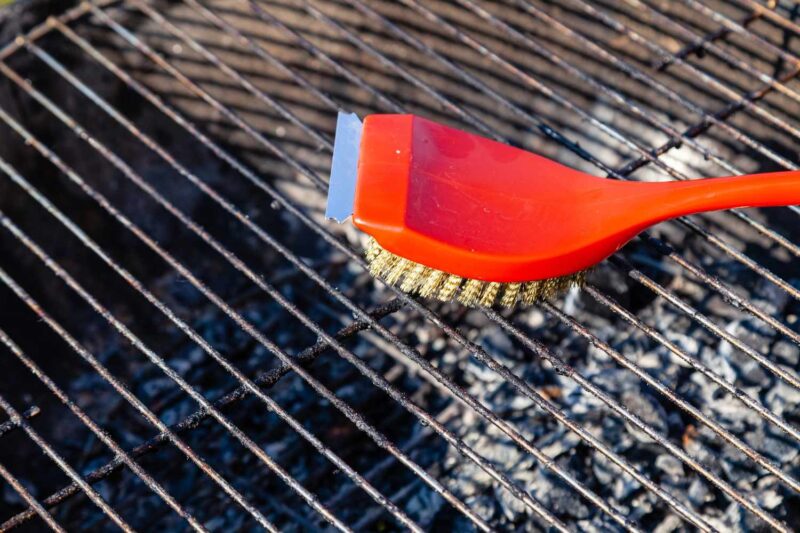
Once the flames have been tamed and the grilling session comes to a close, proper charcoal grill maintenance becomes the crucial next step. A comprehensive approach to cleaning and preparing the grill for its next use not only prolongs its life but also ensures that each barbecuing experience is as exceptional as the last.
Below, I share my methodical process for putting out grill fires and attending to the grill post-use.
My first task is to address the grill grate, which has been subjected to intense heat and residue from the food. It’s vital to clean the grid while it’s still warm, allowing for the easy removal of debris and to prevent any formations that could hinder the grill’s performance over time.
- Begin by thoroughly brushing the grate with a wire grill brush to remove all food particles and any charcoal residue.
- For more stubborn grime, a mixture of warm water and mild detergent can be employed, turning a challenging clean-up into a manageable task.
- Once scrubbed, rinsing with water will wash away any soapy residue, leaving a pristine cooking surface.
After the grate is clean, my attention turns to the remnants of the grill session. Here’s how I manage the left-over charcoal:
- Kicking off excess ash from the briquettes is essential, as this will facilitate their reuse and prevent waste. Safety gloves and tongs are indispensable tools for this job.
- Handpicked charcoal that appears salvageable is returned to the charcoal bag for future barbecues, saving resources and money.
- Unusable remains, on the other hand, are carefully disposed of once completely cooled, ensuring no risk of reigniting is present.
To convey the necessity for diligent post-extinguishing maintenance further, I’ve compiled a table detailing the steps involved and the outcomes they lead to:
| Step | Action | Outcome |
|---|---|---|
| Grill Grate Cleaning | Scrub with brush; Use water and soap if needed. | Clean cooking surface for future use. |
| Charcoal Evaluation | Knock off ash; Salvage reusable briquettes. | Conserve charcoal; Minimize waste. |
| Disposal of Residuals | Dispose of unusable remains after cooling. | Safety ensured; Preparation for next grill session. |
Committing to thorough charcoal grill maintenance post-extinguishing translates to not only efficiency and savings but also plays an integral role in the longevity of the grill and safety of subsequent barbecuing occasions.
In wrapping up my grilling experience, these steps are not merely habitual but engrained in my pursuit of the perfect barbecue. Each act of cleaning, evaluating, and disposing embodies my respect for the art of grilling and the importance I place on grill fire safety and maintenance.
It’s a ritual that assures my beloved grill is always in optimal condition, ready to fire up and impart that unmistakable char-grilled flavor we all cherish.
Grill Fire Safety: Preventing Future Incidents
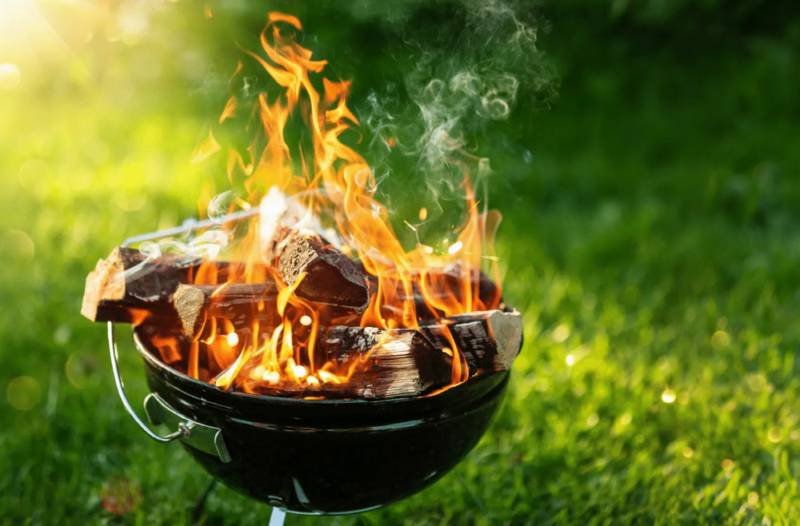
Grilling is not just about mastering the art of cooking over flames; it’s also about ensuring safety before, during, and after you ignite that charcoal. A fundamental part of charcoal grill safety is prevention, which requires a structured approach to temperature control and cleaning.
By instituting practical fire safety tips for charcoal grills, we can look forward to not just delightful barbecues but also peace of mind.
Tips for Monitoring and Controlling Grill Temperature
One of the most critical steps in maintaining grill fire safety is vigilant monitoring of grill temperature. Excessive heat can be just as dangerous as negligent flame management. I consistently rely on vents and dampers to adjust airflow, which, in turn, helps to regulate temperature.
Strategically adding coals also contributes to a steady cooking environment, preventing the grill from becoming too hot too fast.
- Use a quality grill thermometer to keep a consistent check on temperature levels.
- Adjust air intake with bottom vents and release excess heat with top vents to manage the flame.
- Incorporate a drip pan with water underneath the grill grate to maintain moisture and manage flare-ups.
A proper understanding of temperature management guarantees that my grill remains at an optimal level, enhancing both the quality of the food and my overall grilling proficiency.
Understanding the Role of Ventilation and Cleaning
It’s evident that effective ventilation is instrumental in sustaining an even burn and preventing the accumulation of dangerous gases. Therefore, maintaining clean vents is a staple in my charcoal grill maintenance routine.
It ensures that I can control the fire’s intensity and that my grill breathes correctly, eliminating any risks associated with poor airflow.
Similarly, regular cleaning of ash and grease build-up is imperative to avoid unwanted grill fires. These residues can ignite quickly under the right conditions, so I often employ these cleanup habits as soon as the grill cools.
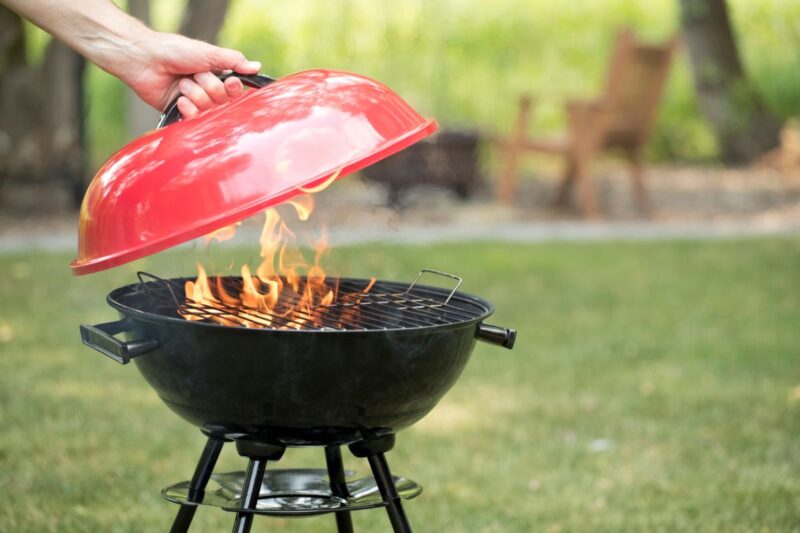
| Cleaning Area | Frequency | Benefits |
|---|---|---|
| Vents and Dampers | After each grilling session | Ensures proper airflow and temperature control |
| Grill Grate and Interior | Regularly or after intensive usage | Prevents grease fires and maintains grill hygiene |
| Ash Disposal Area | After coals are fully extinguished | Reduces the risk of accidental fires |
A cover for the grill has also proven to be an excellent investment, safeguarding the grill from the elements, which in turn prolongs its life and ensures it remains a reliable tool for safe grilling practices.
Ensuring proper ventilation and routine cleaning isn’t mere diligence—it’s a commitment to safe grilling and the longevity of my barbecue equipment.
In conclusion, prevention is a critical aspect of charcoal grill safety. By monitoring temperature, managing airflow, and maintaining a clean grill, I ensure that each barbecuing experience is not just delicious but also devoid of hazardous incidents.
These are the standards I uphold for every cooking session, ensuring I can grill with both confidence and security.
Key Takeaways
- Understanding both the long and quick methods for extinguishing charcoal grills is crucial.
- Shutting the grill’s oxygen supply by closing vents is the key step in both approaches.
- The Weber Kettle’s adjustable vents facilitate a controlled cool-down process.
- Handling hot coals carefully and using safe disposal practices are important for grill safety.
- Knowing when and how to employ each extinguishing method will enhance your grilling experience and safety.
- Proper post-use grill maintenance helps for a safer next cookout.
FAQ
What are the two methods for extinguishing a charcoal grill?
The two methods for extinguishing a charcoal grill are the long method, involving oxygen deprivation, and the quick method, which involves a rapid cool down.
Why is controlling oxygen important when putting out a charcoal grill?
Controlling oxygen is important because oxygen fuels the fire. By closing the lid and vents to cut off the air supply, you starve the fire of oxygen, causing the coals to extinguish.
When is the right time to start extinguishing my charcoal grill?
The right time to start extinguishing your charcoal grill is after you’ve finished cooking and when the coals have burned down and are no longer needed to maintain a cooking temperature.
What tools do I need to safely extinguish my charcoal grill?
You’ll need a wire grill brush, grill tongs, heatproof gloves, a metal bucket for water, and baking soda to safely extinguish your charcoal grill.
What is the long method for putting out a charcoal grill?
The long method involves closing the grill’s lid and vents, which deprives the charcoal of oxygen, allowing the coals to extinguish naturally over time.
What steps should I follow for the quick method to extinguish my grill?
For the quick method, use tongs and heatproof gloves to remove the hot charcoal briquettes and place them in a metal bucket of water. Then scoop out the ash into a metal container.
How should I handle the remaining ash and charcoal after extinguishing the grill?
Once the grill has cooled, remove the remaining ash and any unburnt charcoal. Place ash in foil for disposal, and keep any reusable briquettes for next time.
What is the recommended way to dispose of charcoal ash?
Cooled charcoal ash should be disposed of in a metal container with a lid or wrapped in aluminum foil and placed in the trash. Opt for a container that allows for airflow and is not labeled “No Hot Ashes” to avoid fire hazards.
After extinguishing my grill, what maintenance steps should I take?
After extinguishing your grill, brush clean the grate, remove residual ash, and occasionally use soap and water for thorough cleaning. Store any reusable coals properly.
What are some fire safety tips to prevent future grill incidents?
Regularly clean your grill, especially the vents, to ensure proper airflow. Monitor the temperature with vents and dampers, and maintain a clean grilling area free from flammable materials.
Conclusion: A Fusion of Safety and Technique in Charcoal Grilling
In the realm of grilling, knowing how to put out a charcoal grill is tantamount to the mastery of cooking itself. Proving both environmentally and safety-conscious, the dual methods of grill extinguishment — the patient oxygen deprivation, and the expedient rapid cool down — ensures that I can adapt to any post-barbecue scenario with confidence and care.
It’s about embracing the right charcoal grill extinguish methods that resonate not just with my grilling style but with the imperative of nurturing a secure and enjoyable grilling environment.
My devotion to grill fire safety manifests not only in adopting proper disposal techniques but also in regular maintenance of my beloved barbecue equipment. Through diligent cleaning and waste management, I safeguard my grill’s longevity and enhance my gastronomic adventures. It is a commitment that ensures each grilling experience is a pleasure, devoid of post-cooking hazards or concerns.
As I reflect on the essence of barbecuing, I am reminded that our grilling customs are an interplay of art, science, and responsibility. Terrific flavors and memorable moments around the fire are achieved with knowledge and the utmost respect for safety protocols. This dedication to method and maintenance ensures that the flames of my grill — and the joy of my cooking — continue to burn bright, safely contained until the very last ember is extinguished.

